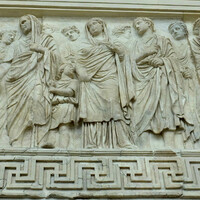Ara Pacis
Date:
13–9 BCE
Location or Findspot (Modern-Day Country):
Italy
Medium:
Marble
Dimensions:
11.6 × 10.6 m (for the walled precinct)
Description:
The Roman senate erected the Ara Pacis Augustae, or Altare of Augustan Peace, in 9 BCE to commemorate Augustus's return from (and victory over) Spain and Gaul four years earlier. It includes a walled precinct with relief decoration. The interior of the precinct is carved with garlands and ox heads. The exterior has acanthus scrolls with animals as well as mythological scenes, allegorical personifications, and a religious procession on two sides that includes the imperial family. It shows Augustus dressed as pontifex maximus (high priest); Marcus Agrippa (Augustus's great general); a prominent female figure who may be Augustus's wife Livia or Agrippa's wife Julia; and many others. The Ara Pacis is notable for its depiction of contemporary women and children and its carving in an idealized classical style.
Download a PDF of the Ara Pacis axon, cutaway, or plan.
Download a PDF of the Ara Pacis axon, cutaway, or plan.
Relevant Textbook Chapter(s):
1
Repository and Online Resources:
• Visit the official website of the Ara Pacis Museum in Rome.
Image Credits:
Wikimedia Commons, Navid Jamali








